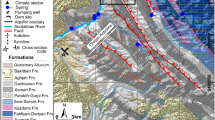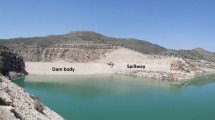Abstract
The excellent topographic condition of the limestone canyons for dam construction may be rejected if they are karstified. Karst features cause the reservoir not to be impermeable enough to permit the water to fill it and leakage occurs and often increases with time. Moreover, karst features may involve the stability of the dam itself. A few operated dam sites at the Zagros Zone encountered a leakage problem. Furthermore, more than 30 dams are presently under study for construction in the Zagros Zone. Karst conditions and leakage potential were investigated at an under-study site (Khersan 3 Dam) for assessing the general methodology for the study of leakage potentials. Conventional methods for studying karst features, geological mapping, geomorphology and extensive borings were applied before the dam was constructed. These methods are not efficient enough to precisely reveal the karst structure, especially hidden and paleokarst, nor the hydrological behaviour of the karst structure in different settings of groundwater flow. Based on the present case study and previous applied approaches by other authors, this paper introduces a methodology by means of karst structure and functioning approaches at local and regional scales that cover the conventional methods and overcome their shortages. The proposed methodology should be applied before construction of a dam and should include three steps (a) recognition of geological and hydrogeological settings, (b) delineation and functioning of the karst system related to the future reservoir, and (c) assessment of the leakage potentials. Following this methodology, the most probable leakage zone(s) and path(s) at the dam site can be highlighted.









Similar content being viewed by others
References
Alavi M (2004) Regional stratigraphy of the Zagros fold-thrust belt of Iran and its proforeland evaluation. Am J Sci 304:1–20
Al-Saigh NH, Mohammed ZS, Dahham MS (1994) Detection of water leakage from dams by self-potential method. J Eng Geol 37:115–121
Altug S, Saticioglu Z (2000) Breke arch dam, Turkey: hydrogeology, karstification and treatment of limestone foundation. Proceeding of present state and future trends of Karst studies, Marmaries, vol Z.1. Turkey, pp 315–323
Anik F (1973) Experience gained in the investigation of karst reservoirs. Commission international DES grands barragas, pp 1519–1540
Asadi N (1997) The study of water tightness problem in Tangab dam by use of dye tracers. M. Sc. thesis, Department of Earth Sciences, Shiraz University, Shiraz
Asadpour R (2000) Hydrogeology of the karstic Ravandi anticline in Seymareh dam using rhodamine-B dye tracer. M. Sc. thesis, Department of Earth Sciences, Shiraz University, Shiraz
Bakalowicz M (1986) La karstification: processus, modeles et examples (Karstification: processes, models and examples), 9 congreso Internacional de Espeleologia, vol III. Barcelona, p. 59–63
Bakalowicz M (2005) Karst groundwater: a challenge for new resources. Hydrogeol J 13:148–160
Bhattacharya SB (1989) Dams on karstic foundation. Ir Power 46(3):37–46
Degirmenci M (1993) Karstification at Beskonak dam site and reservoir area, southern Turkey. Environ Geol 22:111–120
Eraso A (1989) Paleokarst in civil engineering. In: Bosak P, Ford DC, Glazek J, Horacek I (eds) Paleokarst, a systematic and regional review, Elsevier, Amsterdam, p. 525
Ertunc A (1999) The geological problems of the large dams constructed on the Euphrates River (Turkey). J Eng Geol 51:167–182
Fazeli M A (2005) Construction of grout curtain in karstic environment case study: Salam Farsi dam. Proceeding of the international conference and field seminars, Belgrade and Kotor (Serbia and Montenegro), 13–19 September 2005, pp. 659–666
Fischer RW, Greene JA, Ottoson RS, Graham TC (1988) Planning and design considerations in karst terrain. Environ Geol Water Sci 12(2):123–128
Ford DC, Williams PW (1989) Karst geomorphology and hydrology. Unwin Hyman, London
Ghobadi MH, Khanlari GR, Djalaly H (2005) Seepage problems in the right abutment of the Shahid Abbaspour dam, southern Iran. Eng Geol 82:119–126
Guangcheng L, Zhicheng H (2004) Principal engineering geological problems in the Shisanling pumped storage power station, China. J Eng Geol 76:165–176
Handfelt LD, Attwooll WJ (1988) Exploration of karst condition in central Florida, at geotechnical aspects of karst terrains: exploration, foundation designing and performance, and remedial measures, In: Sitar N (ed) Geotechnical special publication No. 14, published by the American society of Civil Engineers, p. 166
Iqbal MA (1995) Engineering experience with limestone. Karst GeoHazards. Balkema, Rotterdam, pp. 463–468
James GA, Wynd JG (1965) Stratigraphic nomenclature of Iranian oil consortium agreement area. Bull Am Assoc Petrol Geol 49(12):2182–2245
Kamali M (1999) Study on the problem of probable water leakage from the Seimareh Dam abutments using uranine tracer. M.Sc. Thesis, Department of Earth Sciences, Shiraz University, Shiraz
Karimi H (2003) Hydrogeological study of aquifers in Kersan 3 Dam area using time variations of physico-chemical parameters. M.Sc. Thesis, Department of Earth Sciences, Shiraz University, Shiraz
Karimi H, Raeisi E, Zare M (2005) Physicochemical time series of karst spring as a tool to differentiate the source of spring water. Carbon Evaporate 20(2):138–147
Kath RL, Mcclean AT, Sullivan WR, Hampheries RW (1995) Engineering impacts of karst: three engineering case studies in cambrian and ordovician carbonates of the valley and ridge province. Karst GeoHazards. Balkema, Rotterdam, pp. 469–474
Keshavarz T (2003) Study on the karstic artesian aquifers in the Khersan 3 Dam site. M. Sc. Thesis, Department of Earth Sciences, Shiraz University, Shiraz
Mahab Ghods consulting engineers (2000) Engineering geology report on Khersan 3 Dam, Unpublished
Maleki E (2005) Application of geophysical studies to investigate karst phenomenon in dam sites and along Ater conveyance tunnels in Iran. Proceeding of the international conference and field seminars, Belgrade and Kotor (Serbia and Montenegro), 13–19 September 2005, pp 545–550
Mangin A (1978) Le karst, entite physique, aborde par l etude du system karstique. (karst as a physical unit, from the study of karst system). Le karst, colloque de Tarbes, 17–18 October 1978, AGSO, pp 21–37
Mangin A (1994) Karst hydrogeology. In: Stanford J, Gibert J, Danielopol D (eds) Groundwater ecology. Academic Press, Dublin, pp 43–67
Marinos PG, Kazilis N (2000) The water-tightness of dams and reservoirs: a classification of Greek cases. Present state and future trends of karst studies, vol 1. Turkey, pp 273–278
Merritt AH (1995) Geotechnical aspects of the design and construction of dams and pressure tunnel in soluble rocks. Karst GeoHazards. Balkema, Rotterdam, p 3–7
Milanovic PT (2001) The special problems of engineering in karst. In: Gunay G, Ford DC, Williams PW, Johnson (eds) Proceeding of present state and future trends of karst studies, UNESCO, pp 45–56
Milanovic PT (2004) Water resources engineering in karst. CRC, pp 312
Mohammadi Z, Raeisi E (2005) The uncertainties in hydrogeological study in karstic dam site, 73th annual meeting of ICOLD, Tehran, Iran, May 1–5, paper no. 067–S3
Mohammadi Z, Raeisi E, Bakalowicz M (2006a) Evidence of karst from behavior of the Asmari Limestone aquifer at the Khersan 3 Dam site, Southern Iran. Hydrol Sci J (in press)
Mohammadi Z, Raeisi E, Zare M (2006b) A dye tracing test as an aid of karst development study at the artesian limestone sub-aquifer: Zagros Zone, Iran, Environmental Geology (in press)
Pollak D (2000) Engineering–geological investigations of karst terrain. Proceeding of present state and future trends of karst studies, Marmaries, vol 1. Turkey, pp 295–305
Redwine JC (1993) Logan Martin dam deep grouting program: hydrogeologic framework in folded and faulted appalachian karst. Applied karst geology. Balkema, Rotterdam, pp 243–253
Satti ME (2000) Engineering karst study in Kowsar dam site. Proceeding of present state and future trends of karst studies, Marmaries, vol 1. Turkey, pp 325–329
Soderberg AD (1979) Expect the unexpected: foundations for dams in karst. Bull Assoc Eng Geol 16(3):409–425
Stocklin J (1968) Structural history and tectonics map of Iran: a review. Am Assoc Petrol Geol Bull 52(7):1229–1258
Stocklin J, Setudehnia A (1977) Stratigraphic lexicon of Iran. Geological Survey of Iran, 376 p
Talaei H (1999) Investigation on the flow path through the karstic formation of the left abutment of Tangab dam by the means of rhodamine-B dye tracer. M. Sc. Thesis, Department of Earth Sciences, Shiraz University, Shiraz
The international committee of large dams (ICOLD) (2005) Int J Hydropower Dams, 12. Special issue, p 110
Turkmen S, Ozguler E, Taga H, Karaogullarindan T (2002) Seepage problems in the karstic limestone foundation of the Kalecik Dam (south of Turkey). J Eng Geol 63:247–257
Uromeihy A (2000) The Lar Dam: an example of infrastructural development in a geologically active karstic region. J Asian Sci 18: 25–31
White WB (1988) Geomorphology and hydrology of karst terrains. Oxford University Press, 464 p
Xu R, Yan F (2004) Karst geology and engineering treatment in the Geheyan project on the Qingjiang River, China. J. Eng Geol 76:155–164
Acknowledgments
The authors would like to acknowledge the financial support of the Iran water and Power Resources Development Company (IWPCO) and Shiraz University for continuous support. The authors also wish to thank Prof. P. Milanovic, his comments improved this paper.
Author information
Authors and Affiliations
Corresponding author
Rights and permissions
About this article
Cite this article
Mohammadi, Z., Raeisi, E. & Bakalowicz, M. Method of leakage study at the karst dam site. A case study: Khersan 3 Dam, Iran. Environ Geol 52, 1053–1065 (2007). https://doi.org/10.1007/s00254-006-0545-1
Received:
Accepted:
Published:
Issue Date:
DOI: https://doi.org/10.1007/s00254-006-0545-1




